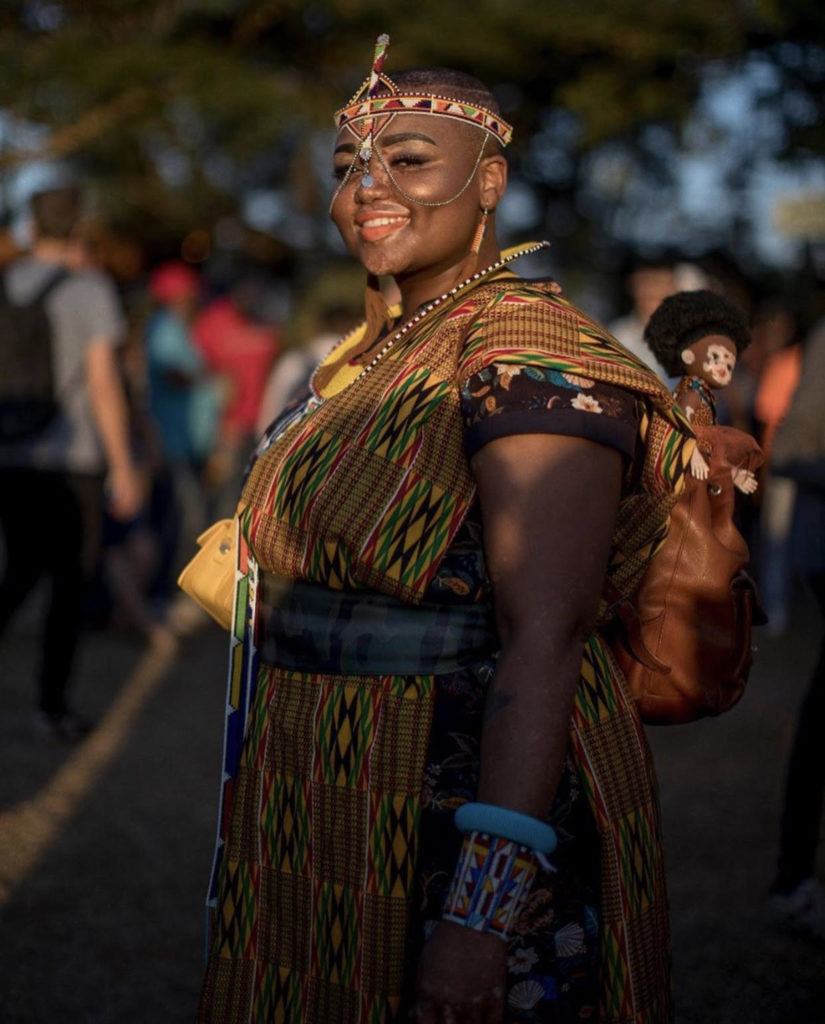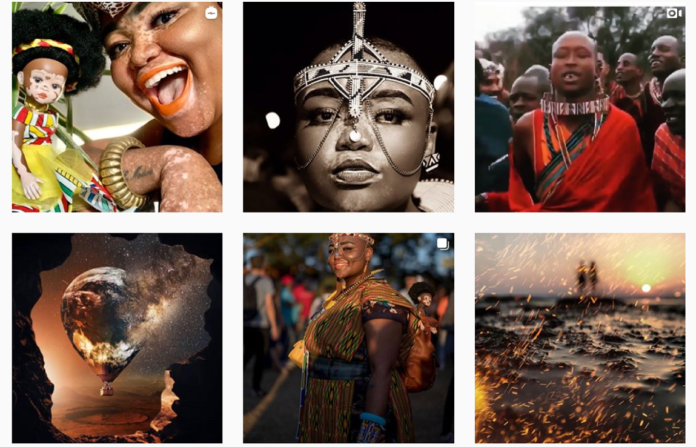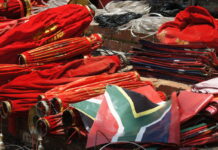Boitumelo Rametsi believes in accepting your present-day self. The Soweto-born and based creative founded Spotted Beauty, a project that evolved from her personal Facebook page in 2012, to raise awareness around vitiligo. Vitiligo is a skin condition that causes skin to lose its pigment cells and change colour. Rametsi is also a body positive model. Both aspects of her identity has helped Rametsi see beauty as a celebration of an individual’s own evolution. Rametsi took The Daily Vox through her journey of self-acceptance.
Rametsi’s brand reflects her journey
Besides being a creative and a model, Rametsi is a qualified brand strategist who has worked in the media industry since 2013. While Rametsi was working at her first job, she started the makeup company B Glam SA. Rametsi says she and her brand are aligned, and she drives her brand according to her own journey.
When Rametsi started B Glam SA, it was to use makeup to cover her vitiligo. Her brand strategy followed the trends at the time with a full face of makeup, contouring and highlighting. “I was not always this confident. I wanted to look like everybody else and I used makeup to do it, so I started a brand of my own. That was aligned to me covering up my spots because I was very uncomfortable feeling the way I did,” Rametsi says.
Rametsi was not born with vitiligo. Her pigmentation was only visible to her when she was 12. By the time that she entered varsity, it had spread rapidly across her body.
“In high school, [my vitiligo] wasn’t such a big deal. But in varsity, it started appearing on my face. I was driving [to university every day] and the right side of my body started getting more spots because I was affected by the sun. The sun makes the spots spread vigorously,” Rametsi says.
She had difficulties accepting how rapidly her appearance was changing. Rametsi says it was a traumatic period; she was very unhappy, and even told her mom she wouldn’t have children. Her journey has been one of self-acceptance and self-discovery.
Through her journey, Rametsi learned to accept herself as she was, and she then morphed her brand strategy. “I just wanted to let my skin breathe. I moved from [my previous brand strategy] to: ‘What makes you different makes you beautiful,’” she says.
That’s when she created Spotted Beauty as a sister brand to B Glam SA. Spotted Beauty grew as Rametsi began modelling, and bringing awareness to vitiligo. “It became a journey through my brand and me realising and going through the experiences that got me here now,” she says.
Rametsi’s definition of beauty is influenced by this journey.

“Beauty is celebrating your ever-evolving being”
“The definition of beauty is rising to the occasion and always celebrating your ever-evolving being,” Rametsi says. As human beings, we are constantly changing and we will never look the way we do right now.
“We have this obsession with always trying to look the same. You want to go back to the way you were when you were 16, you want to fit into your 18-year-old jeans. You want to have this look and have it all the time,” Rametsi says.
With vitiligo, there is even less of a sense of permanence. This taught Rametsi to quit putting herself in a box and saying, ‘This is how I look’. “With vitiligo, it makes it even harder because everytime I think that, I change. It happens without me even realising it. You just get a few spots out of nowhere and you’re wondering, ‘What?’”
“What I’ve come to realise is that beauty is accepting your current and present moment as you are now. That’s also what being body positive is: accepting who you are now. Celebrate who you are now, not when you become something because that shows that you really don’t see yourself as an acceptable person. You’re really an acceptable person right now,” she says.
We set beauty standards according to what’s trending, but identity is not a trend
Rametsi thinks South African beauty standards have moved away from Eurocentric beauty standards. The difference is that now is that we set beauty standards according to what’s trending.
When she was growing up, there was a “Barbie doll” image of beauty: blond hair, blue eyes and being skinny. Then it moved on to the Kim Kardashian image of beauty: super long dark hair, light skin and the most amazing contour. “For a while, even black people started to look like Kim Kardashian,” Rametsi laughs.
But what isn’t up for the next trend is Rametsi’s identity. She spoke on a panel discussing identity and trends at the Beauty Revolution Festival held in Johannesburg between 6-7 April.
“Vitiligo and albinism became a trend at one point,” Rametsi says. Sometimes a definition of beauty arises when people are trying to define and understand something. Once they’ve understood it, they leave it and it’s no longer a trend, she says.
Model Winnie Harlow, who has vitiligo, has risen to prominence in recent years. “People think I got my inspiration and power from Winnie Harlow. During the panel discussion, we were talking about how brands also fall prey to the trends. Once Winnie Harlow’s on the cover of every magazine, then every brand wants a specific type of person [in their campaigns] because they want to be included in looking like they celebrate different people,” she says.
“People think because Winnie Harlow is [so visible], then it makes everything easier and better for me. That’s not the case,” Rametsi says.
And neither of them are defined by their vitiligo.
No one person is the “face of vitiligo”
Rametsi is not worried about people seeing her as the “face of vitiligo”. “Winnie Harlow does not see herself as the face of vitiligo. That’s why she’s always talking about how she’s a human being, who is a model, who has dreams and aspirations like every other person. She doesn’t want to be defined by her vitiligo,” she said.
But with her experience, Rametsi has seen that you do not always choose which aspect you of your identity you represent. “I’m not afraid to be known as the girl with vitiligo, because I have vitiligo. Why am I trying to detach myself from who I am?” she says. But there is more than her vitiligo.
“There are so many manifestations of myself. There’s so many different parts of me. There’s no reason to confine myself to just a ‘vitiligo model’,” Rametsi says.
Being outspoken about her vitiligo, Rametsi has received all types of feedback from people. People often thank her for helping them accept themselves. “I’ve received people who want to talk about people they know who have vitiligo. They show them my page and those people feel so much better and happier. It’s what drives me to keep going, I just need to continue doing what I need to do,” she says.
But sometimes Rametsi gets comments from people saying that they wish they had vitiligo, because it’s a trend. “I engage with them and ask them, why do they feel they need to be a certain way?” she says.
Perhaps it’s because her visibility has created a community, and some people feel apart from it. Rametsi believes we can all form part of a community if more people spoke up about their identities and experiences. “Nobody is alone, everyone has something that they experience, that a lot of other people experience. They just choose not to talk about it,” she says.
Rametsi’s journey has been one of self-realisation and she believes most people experience hardship because they need to understand who they really are. “We’re temporary, we’re spiritual beings having temporary human experiences. It’s so much bigger than this,” she says.
“My message is for people to know: You’re so much bigger than this. You are literally the walking embodiment of God consciousness. Carry yourself that way,” Rametsi finishes.
Follow Rametsi on Instagram @boitumelo_spotted.









